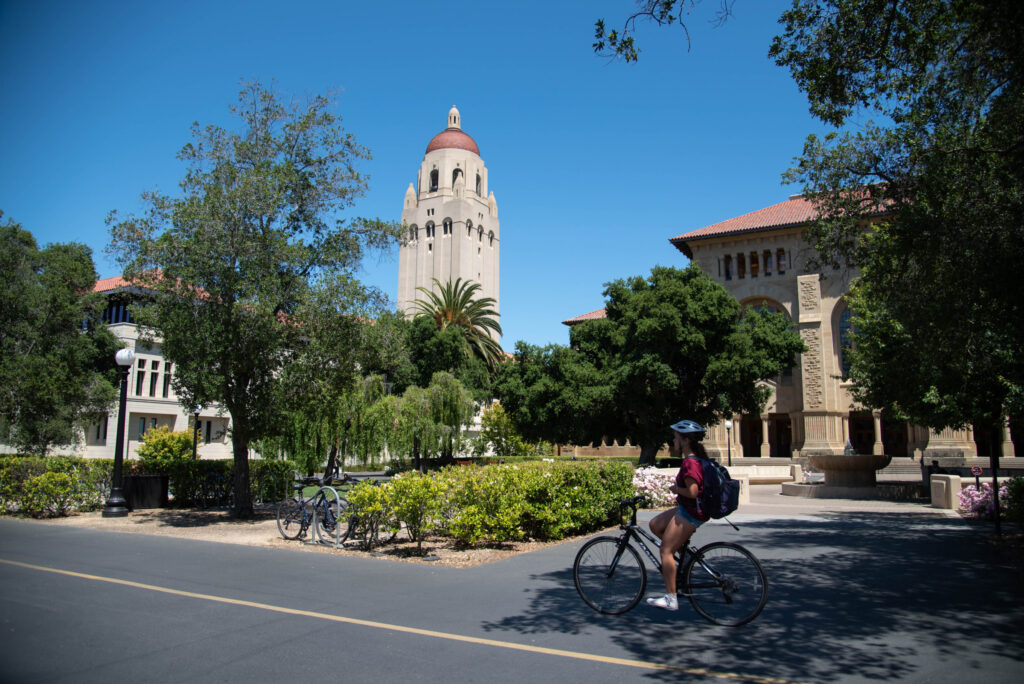Update to Stanford Community Plan aims to reduce university’s impact on neighboring cities
Uploaded: Thu, Jul 21, 2022, 1:30 pm
 Santa Clara County is preparing to update the Stanford Community Plan to require more housing construction as part of any future university expansion. Embarcadero Media file photo by Sinead Chang.
Santa Clara County is preparing to update the Stanford Community Plan to require more housing construction as part of any future university expansion. Embarcadero Media file photo by Sinead Chang.
When Stanford University proposed a plan to add more than 3 million square feet of development to its campus six years ago, Santa Clara County officials insisted that the university manage this growth by building more housing and adopting stringent transportation restrictions.
These policies, as well as a prolonged dispute between the university and the county over a possible development agreement, ultimately doomed Stanford’s effort, prompting it to withdraw its application for a general use permit in 2019. Now, however, county officials are preparing to resurrect and codify some of the same policies as part of a new community plan that would govern future proposals from Stanford for academic growth.
The changes, which Stanford is resisting, are part of an update to the Stanford Community Plan, a land use document that the county first adopted in 2000 and that lays out policies for growth in the roughly 4,000 acres of Stanford land in unincorporated Santa Clara County. County planners and consultants are now revising the document and county’s Planning Commission is preparing to get its first look at the new chapters over two meetings in August.
A key goal of the update is to ensure that any future growth plan that Stanford presents includes enough housing to accommodate any expansion of academic space. The existing plan, by contrast, allows the university to pay an “in-lieu” fee to the county to support construction of new affordable housing. The proposed update would eliminate that option and require the university to build the housing.
In another major policy change, the county would require most of the new housing to be constructed either on or next to the Stanford campus. The goal is to reduce the impact of any potential growth on neighboring communities, including Palo Alto and Menlo Park, where Stanford has been buying up or building homes.
Matheou told the commission on June 14 that while 90% of Stanford’s faculty and staff live in Santa Clara, San Mateo and San Francisco counties, only 7% of faculty and staff live on campus. The university provides subsidies to cover a portion of the housing costs for those who live away from campus. Next year, it plans to extend this policy to staff who live in Oakland and San Jose, Matheou told the commission.
“While initiatives like these are important to Stanford efforts to provide gap financing and reduce housing costs, the challenge of meeting the university’s demand for housing remains,” Matheou said.
Requiring Stanford to construct housing on campus would “reduce competition for off-campus housing, thereby reducing the price pressures on surrounding areas and would also provide affordable housing in and close to campus,” she said.
A new policy that consultants are proposing as part of the update would require that at least 70% of all the new housing — both market rate and affordable — be built on campus. A maximum of 30% of the housing would be built on land contiguous to the Community Plan area.
“You end up getting the money in today’s dollars or yesterday’s dollars and then having to spend it in the future,” Levy said of in-lieu fees. “And you end up having to spend a lot more money than you collected.”
Commission Chair Vicki Moore also suggested that the existing fee program may be insufficient when it comes to satisfying the housing demand.
“The actual cost of construction ends up being in general higher than is anticipated when fees are collected, therefore you don’t produce as many units as you might expect.”
The proposed requirements for new housing are facing some pushback from Stanford, which is pointing to the growing number of employees who are working remotely, in some cases outside California. Others are working through a “hybrid” model, which allows them to work on campus as often as they want to. The university is looking for flexibility, said Jessica von Borck, Stanford’s director of land use.
New direction on transportation policies causes divergence

Santa Clara County has proposed new transportation policies in an update to the Stanford Community Plan, including ones aimed at traffic congestion. Photo taken Nov. 12, 2012 by Veronica Weber.
Other policies proposed by the M-Group take aim at traffic congestion. Stanford is already subject to a “no net new commute trips” standard that it has successfully met through a broad range of transportation-demand-management initiatives, including shuttles and carpool programs. That standard would remain in the new Stanford Community Plan. However, rather than focusing on only the peak hour of the morning and afternoon commutes, the standard would now be based on three-hour periods and would also consider reverse-commute trips.
The county is also shifting away from an existing policy that requires Stanford to fund intersection improvements if the traffic impacts of its growth exceed the “no net new commute trips” threshold. The new policy would allow Stanford to look beyond the intersections and fund bike and pedestrian improvements throughout an expanded area that includes East Palo Alto and the Belle Haven and Bayfront neighborhoods in Menlo Park.
At the same time, the county would remove a “fair share” policy in the existing plan that would require Stanford to contribute funding for intersection improvements that reduce congestion. Because of Stanford’s success in managing its traffic levels, that policy has never been put in effect.
Geoff Bradley, project manager with M-Group, said the goal is to avoid a situation in which agencies respond to growing traffic levels in urban areas by continuously expanding road capacity.
“At some point the cure is worse than the disease when you’re talking about expanding roads in built-up areas,” Bradley said. “The challenge then becomes not to have bigger and bigger roads and more and more high-volume intersections but move toward reducing vehicle trips, increasing transit reliance and making it more attractive for people not to need cars.”
Not everyone is sold on the new transportation policies. Vince Rocha, vice president of housing and community development at the Silicon Valley Leadership Group, suggested that including reverse trips in the calculations amounts to “double counting” and noted that traffic studies generally don’t use this metric.
‘At some point the cure is worse than the disease when you’re talking about expanding roads in built-up areas.’
-Geoff Bradley, project manager, M-Group
“Maybe reverse trips aren’t necessarily bad trips,” Rocha said. “They encourage use of local amenities. I know the region around the university has tons of jobs and restaurants and other amenities that people may want to utilize.”
Von Borck also suggested that including reverse commute trips as a metric would conflict with the county’s goal of increasing housing on campus. Households, she noted, generate vehicular trips at a higher rate than academic uses. She called the proposal “an antiquated way to address traffic impacts.”
Bradley acknowledged that the county is treating Stanford differently than it would other applicants and attributed that to the university’s unique status in the land use arena. Unlike other applicants, Stanford is not subject to conventional zoning standards. The county’s community plan, he noted, gives Stanford a significant amount of flexibility to accommodate new growth, provided it meets the performance standards established by the county.
“Stanford can see the limit and they can use all their creativity and intellectual capital to figure out how to live within that, which they’ve done very successfully with the no net commute standard,” Bradley said.


